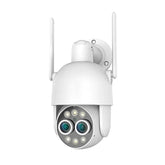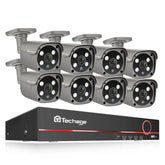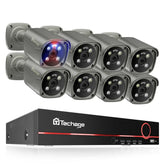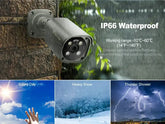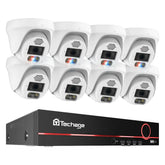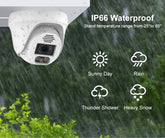Exploring the Integration of IP Cameras and Access Control Systems
In the realm of security and surveillance, the integration of IP cameras and access control systems has revolutionized the way organizations protect their assets and ensure the safety of their premises. IP cameras, with their advanced video capture capabilities, and access control systems, which govern entry and exit points, can work in tandem to provide a comprehensive security solution. This article delves into the exploration of the integration between IP cameras and access control systems, highlighting the benefits, functionalities, and considerations involved in this powerful combination.
Enhanced Security and Surveillance
By integrating IP cameras with access control systems, organizations can achieve heightened security and surveillance capabilities. IP cameras capture high-resolution video footage that can be streamed and recorded in real-time. This enables security personnel to monitor critical areas, identify potential threats, and respond swiftly to security incidents. By combining access control systems, which regulate and monitor entry points, with IP cameras, organizations can maintain a comprehensive view of who enters and exits the premises, bolstering security measures and deterring unauthorized access.
Visual Verification and Auditing
Integrating IP cameras with access control systems enables visual verification of access events. When an access card or biometric credential is presented, the corresponding video feed from the IP camera can be displayed, providing visual confirmation of the person's identity. This visual audit trail enhances accountability and aids in investigations by providing a clear record of who accessed specific areas at a given time. It also serves as a deterrent against fraudulent activities or misuse of access credentials.
Real-time Monitoring and Event Notification
The integration of IP cameras and access control systems allows for real-time monitoring and event notification. When an access control system grants or denies access to an individual, corresponding IP cameras can be triggered to focus on the specific entry point, capturing the event on video. Security personnel can receive instant notifications and view live video feeds to verify the identity of individuals, ensuring compliance with access policies. In the case of unauthorized access attempts or suspicious activities, immediate alerts can be generated, enabling quick intervention and response.
Video Verification and Forensic Investigation
Integrating IP cameras with access control systems enables video verification and forensic investigation. When an access control event occurs, such as the presentation of an access card or biometric authentication, the corresponding video footage from the IP cameras can be synchronized with the event data. This synchronization allows for accurate verification and documentation of access events, making it easier to identify and investigate security incidents or disputes. By linking access control events with video evidence, organizations can enhance accountability, resolve conflicts, and provide concrete evidence when required.
Centralized Management and Scalability
The integration of IP cameras and access control systems offers centralized management and scalability. Through a unified management platform, security administrators can efficiently monitor and manage both the video surveillance and access control components. This centralized approach simplifies system administration, reduces maintenance efforts, and enhances operational efficiency. Additionally, as organizations expand or modify their security infrastructure, the integrated solution can be easily scaled and adapted to accommodate evolving needs.
Data Analytics and Insights:
The integration of IP cameras and access control systems opens up possibilities for data analytics and insights. By analyzing access control data in conjunction with video footage, organizations can identify patterns, detect anomalies, and derive valuable insights for improving security protocols. Data-driven analytics can help identify areas of vulnerability, optimize security resource allocation, and enhance overall security effectiveness.
Enhanced Decision-making and Efficiency
The integration of IP cameras and access control systems facilitates enhanced decision-making and operational efficiency. Security personnel can access a unified interface that provides a holistic view of the security ecosystem. By analyzing real-time video feeds and access control data, they can make informed decisions promptly. For example, during emergency situations or security breaches, security personnel can quickly identify the affected areas, assess the situation, and take appropriate actions. The integration also streamlines workflows, reducing manual efforts in managing separate security systems and optimizing resource allocation.
Scalability and Future-proofing:
IP cameras and access control systems are inherently scalable, allowing organizations to expand their security infrastructure as needed. The integration of these systems ensures compatibility and future-proofing, enabling seamless integration with other security technologies and systems. As security needs evolve, organizations can easily incorporate additional IP cameras or access control devices without significant disruptions to the existing infrastructure.
Considerations and Best Practices
While the integration of IP cameras and access control systems offers numerous benefits, certain considerations and best practices should be followed:
- Compatibility: Ensure that the IP cameras and access control systems are compatible and can communicate seamlessly.
- Network Infrastructure: Ensure that the network infrastructure is robust enough to handle the increased bandwidth requirements of both IP cameras and access control systems.
- Data Security: Implement appropriate measures to secure the integrated system, including encryption, user authentication, and regular software updates to mitigate potential vulnerabilities.
- System Design and Configuration: Work with experienced professionals to design and configure the integrated system to meet specific security needs, ensuring proper camera placement, coverage,and access control policies.
The integration of IP cameras and access control systems provides organizations with a powerful security solution that enhances surveillance, access control, and overall safety. By combining high-quality video capture, real-time monitoring, centralized management, and scalability, organizations can achieve comprehensive security coverage and efficient operational workflows. However, careful consideration of compatibility, network infrastructure, data security, and system design is essential to ensure the successful implementation of the integrated system. Embracing this integration enables organizations to safeguard their assets, protect their premises, and create a secure environment for employees and stakeholders.
this integration enhances security measures, improves response capabilities, and streamlines security operations. Organizations can benefit from a seamless and unified security infrastructure that leverages the strengths of IP cameras and access control systems, offering a robust defense against unauthorized access and ensuring the safety of their premises and personnel.




